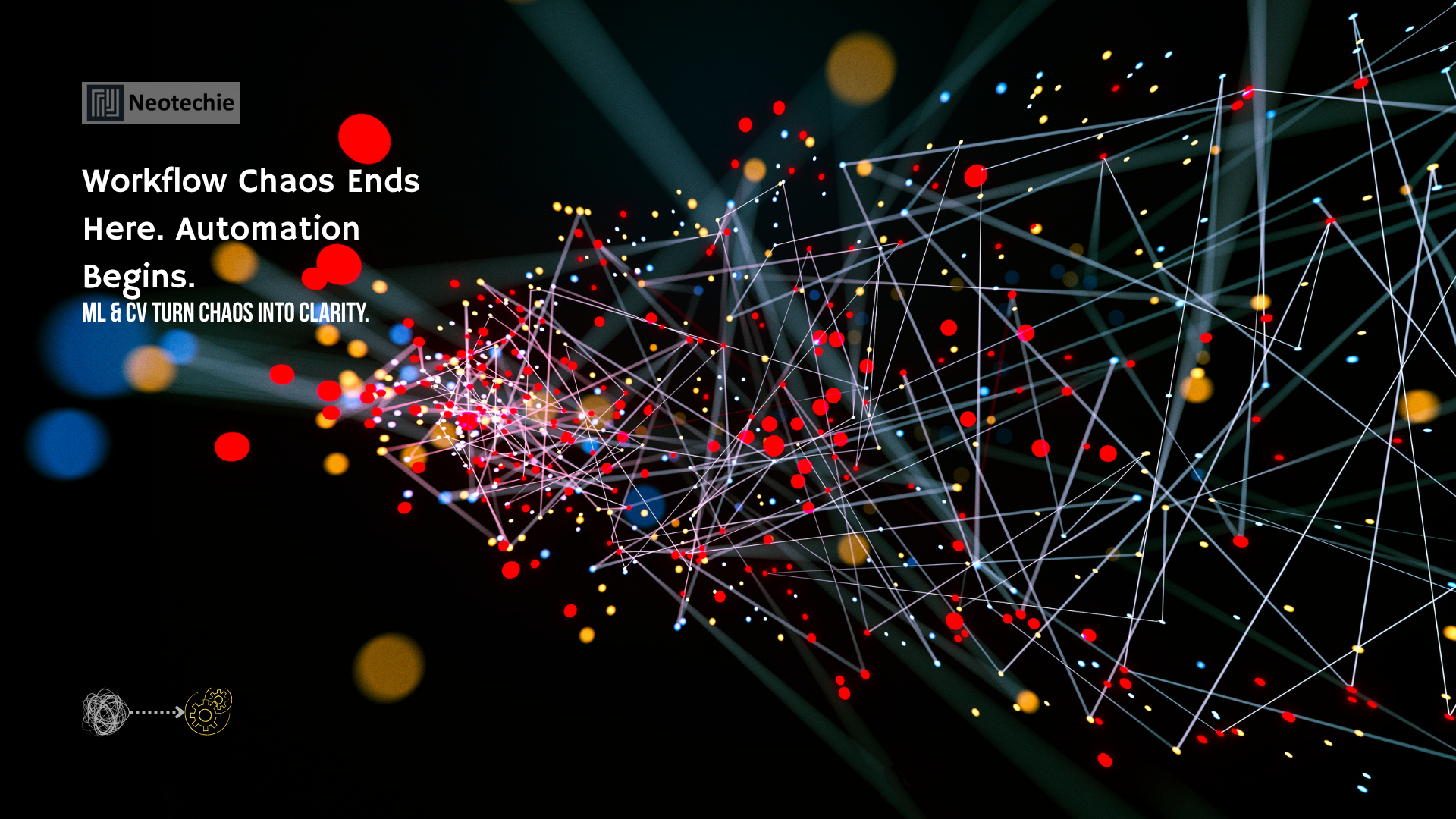From Workflow Chaos to Automation Clarity — Powered by ML & CV
Workflows are the silent engine of every business—but too often, that engine runs with missing parts, outdated processes, or invisible bottlenecks. Many teams operate on undocumented workflows, informal know-how, or chaotic digital routines stitched together across departments and tools. This chaos leads to inefficiencies, delays, and lost revenue.
So how do you untangle the mess and turn it into a streamlined system of automation-ready operations? The answer lies in combining Machine Learning (ML) and Computer Vision (CV) to bring order, insight, and structure to even the most convoluted business processes.
What Does Workflow Chaos Look Like?
Workflow chaos manifests in several recognizable ways:
- Manual data entries across multiple systems: When employees are entering the same information into different platforms by hand, it increases the likelihood of errors and wastes valuable time.
- Dependency on individual knowledge instead of shared procedures: If processes live only in employees’ heads rather than in formal documentation or systems, business continuity is at constant risk.
- Redundant or looping approval processes: Unnecessary steps or approval layers clog up productivity and create bottlenecks.
- Undefined task ownership: Tasks often fall through the cracks when it’s unclear who’s responsible at each stage of the workflow.
- Lack of transparency or visibility into end-to-end workflows: Teams may only see their portion of the process, leading to misalignment and missed deadlines.
In this environment, even basic tasks take longer, errors increase, and scaling becomes a nightmare. Most importantly, leadership often doesn’t realize how deep the inefficiencies go until the impact shows up in the bottom line.
From Messy to Mapped: How ML and CV Decode Complexity
Machine Learning and Computer Vision act like intelligent observers. Rather than relying on interviews or outdated documentation, they observe workflows in motion:
- Real-Time Interface Monitoring
CV captures how users interact with digital interfaces—tracking mouse movements, clicks, scrolls, field interactions, and screen time. This creates a rich dataset reflecting actual behavior instead of assumed workflows. - Pattern Recognition via ML
Machine Learning then processes this data to identify repeated sequences, outlier behavior, bottlenecks, and loops. It decodes hidden dependencies and helps generate reliable process maps based on real usage. - Task Dependency Mapping
ML connects the dots between isolated actions to reveal how tasks move across systems, departments, and platforms. This exposes where delays, gaps, or duplicated work happen. - Visual Process Models
The end result is a visual representation of your business processes, showing each step and how they interlink. These models are easy to understand and provide a foundation for making data-driven automation decisions.
Unlocking Automation Opportunities from Complexity
Once ML and CV have decoded the complex workflows, businesses gain actionable insight to:
- Eliminate duplication: Identify where different teams perform similar tasks separately, then streamline them.
- Automate repetitive workflows: Detect frequently repeated tasks and use RPA (Robotic Process Automation) or AI bots to take over.
- Redesign inefficient interfaces: Interface analysis helps developers optimize UI/UX for better speed and clarity.
- Introduce AI assistants: In areas where decision-making consumes too much time, predictive ML models can assist employees in making faster, more accurate choices.
This clarity enables proactive redesign and automation planning, turning complexity into efficiency.
Why Documentation Alone Isn’t Enough
While traditional process documentation is valuable, it’s inherently limited:
- Static snapshots: Documents quickly become outdated in fast-moving environments.
- Subjective reporting: Written processes often reflect what’s supposed to happen, not what actually happens.
- Blind spots: Informal practices and shortcuts taken by employees rarely make it into official SOPs.
AI-driven discovery using ML and CV provides an objective, real-time, and adaptive view of how work is done, giving leaders tools they can trust.
Business Transformation from the Ground Up
Digital transformation is not just about adopting tools—it’s about reshaping how work is done. With ML and CV insights, businesses can:
- Reengineer operations: Replace inefficient workflows with smart, optimized processes built for scalability.
- Boost team productivity: Free employees from mundane tasks and empower them to focus on creative or strategic work.
- Enable data-driven decisions: Leaders gain a bird’s-eye view of operations and can make informed decisions faster.
- Establish a foundation for long-term automation: With clarity, companies can invest in scalable, flexible automation that grows with them.
Ultimately, this leads to reduced operational friction, stronger ROI, and the ability to innovate confidently.
The Cost of Staying in the Dark
Organizations that continue operating without process visibility face hidden costs:
- Higher operational costs: Manual work and inefficient processes drive up payroll and resource spend.
- Slower service delivery: Customer-facing processes suffer delays, affecting satisfaction.
- Lower employee engagement: Staff stuck in tedious workflows experience burnout and turnover.
- Missed automation ROI: Without clarity, automation efforts are misdirected or underutilized.
Clarity isn’t a luxury—it’s a competitive necessity.
From Chaos to Clarity — with Neotechie’s Process Discovery
Neotechie’s Process Discovery service uses Advanced Machine Learning and Computer Vision technologies to analyze your existing business processes and identify areas ripe for automation. By examining workflows and capturing visual data from documents or digital interfaces, our solution highlights inefficiencies, bottlenecks, and repetitive tasks, giving you a clear roadmap for where automation can have the most impact.
We don’t just observe—we reveal your operational blueprint. From visual clutter to automation clarity, Neotechie transforms the way you work.

